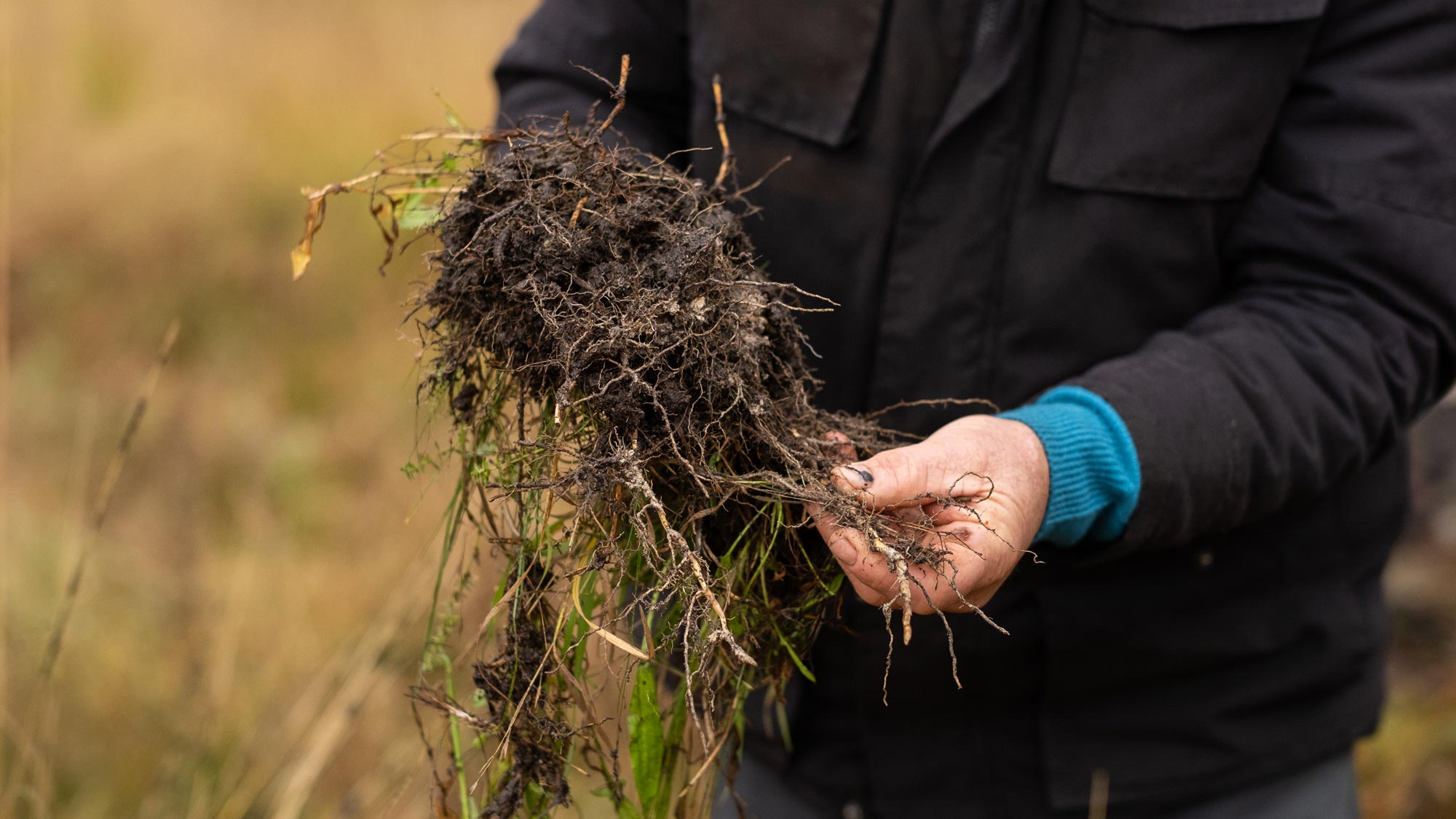Chapter 7.1 Build and maintain soil fertility
Background information
Building up and maintaining soil fertility is one of the most cost-effective investments than can be made in a grazing enterprise. Many Australian soils are naturally inherently low in nutrients, these nutrients can be removed in animal products (meat and wool) and hay, silage and grain.
Laboratory soil tests, plant tissue tests and the use of fertiliser test strips can all assist in making sure that the right amount of the correct fertiliser is being applied to meet your pasture growth objectives.
At a glance
- Develop a soil testing program for your property to determine if nutrients are limiting pasture growth
- Use the tools in this module to determine appropriate capital and maintenance fertiliser rates to address soil nutrient deficiencies.
The decisions relating to fertiliser application (such as the type that most suits your operation and the rates you might use) are essentially about pasture growth and maximising profit and are dealt with in this module.
Tool 6.6 in MMFS Module 6 Healthy Soils contains instructions for collecting soil samples for laboratory testing. Identifying soil health problems and assessing the need for remedial action or special management are addressed in chapter 6.3 and chapter 6.4 in MMFS Module 6 Healthy Soils.
Poor soil nutrient availability contributes to low pasture growth, low levels of desirable grasses and legumes and poor feed quality across most of the high rainfall and sheep-wheat zones of Australia.
Without gathering some objective information, it is very hard to assess the nutrient levels of the different soil types or management units on your property. There are three ways to get this information:
- A laboratory soil test will identify if the macro elements (nitrogen, phosphorus, potassium and sulphur) are limiting pasture growth. Nitrogen (N) is very mobile in the soil and readily utilised by plants, so changes from season to season depending on plant growth and organic matter and legume breakdown). Standard laboratory soil tests are not the most accurate method of testing for trace element requirements, as it’s difficult to detect the relatively minute amounts (trace elements are most accurately measured by plant tissue testing). Tool 6.6 in MMFS Module 6 Healthy Soils outlines the procedure for collecting soil for a laboratory test. Soil tests also give you information about soil health (acidity, salinity, sodicity, etc., and whether your soil might be responsive to lime, gypsum or added nutrients in fertiliser). These issues are dealt with in Chapter 6.3 in MMFS Module 6 Healthy Soils. Use to help interpret soil tests.
- Plant tissue tests are more effective than soil tests in assessing whether trace elements are limiting pasture growth. Trace elements include molybdenum, copper, zinc and boron. Experienced local farmers, agronomists or veterinarians will know if trace element deficiencies are likely in your district. If you wish to assess the trace element requirements for pasture growth, take a sample of the most dominant species in the paddock during spring and submit samples to a reputable laboratory (see signposts). You will need to contact the laboratory or advisor to get the correct sampling technique for the trace element you are testing for.
- Do it yourself, using fertiliser test strips. This method is particularly useful if your soil test results show marginal results for certain elements. This way, you can directly assess the likely response from fertiliser applications by laying out test strips in your paddock, as these can be used for any fertiliser type and are suited to situations where deficiency symptoms are not highly characteristic or where you want to test non-traditional fertilisers. Use tool 7.2 to set up and monitor your own fertiliser test strip.
Understanding pasture response to nutrients
Two examples of how much extra pasture can be grown, when nutrient deficiencies are corrected, are shown in figure 7.2 for an introduced pasture at Hamilton (Victoria) and a native pasture at Orange (NSW).
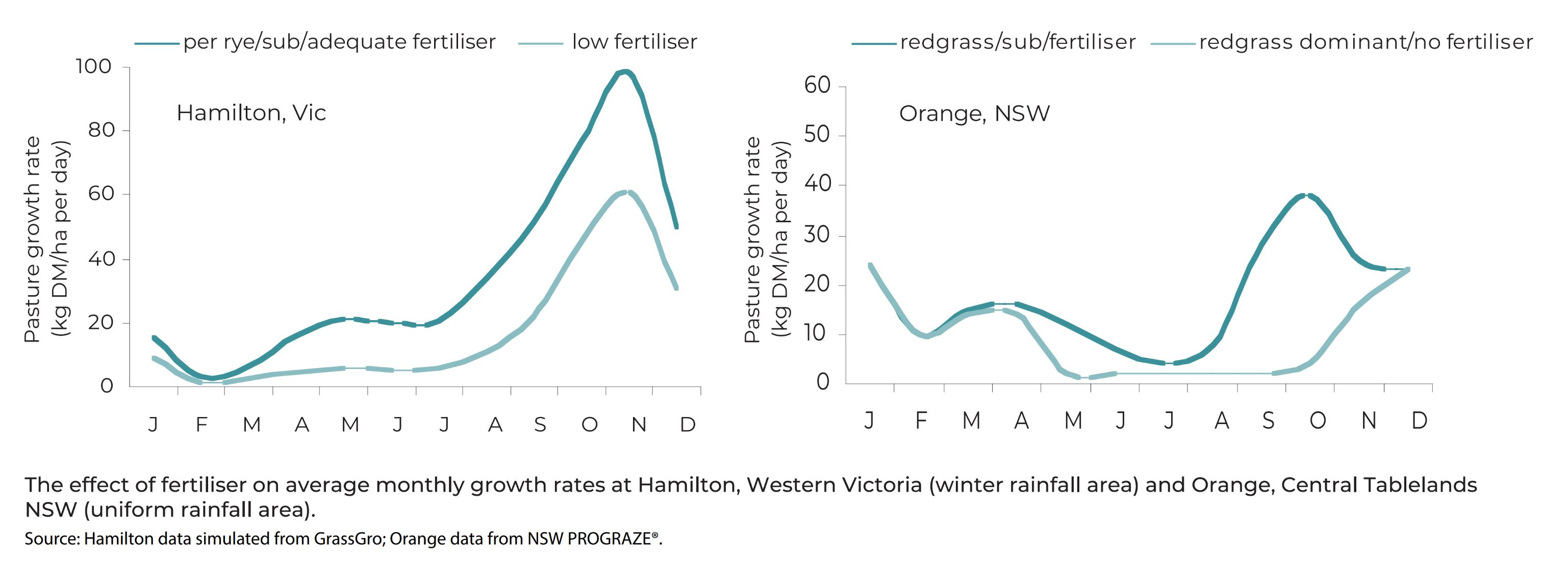
Phosphorus and native pastures
Native pastures containing some legume (e.g., clover, lucerne, serradella, medic) will respond to low rates of phosphorus (P) fertiliser. However, native species can decline under competition from clover, annual grasses or broadleaf weeds if fertility levels are raised and the additional feed not utilised. For native pastures, about 20% legume content in spring is the recommended maximum level.
For native grass pastures in high conservation areas or where an increase in native species diversity is desired, do not apply fertiliser or legume seed as both will reduce the conservation value.
Phosphorus and introduced pastures
Improved (also called exotic or introduced) pasture species have a higher requirement for nutrients than native grasses so fertilising paddocks with these species will give a bigger response and is essential for optimum production.
Generally, it is the legume component of the pasture which gives the immediate production and feed quality response to P fertilisers such as superphosphate if there are no other limiting factors such as acid soil. The legumes fix N, which becomes available to the grasses when the legume roots die off.
Nitrogen fertiliser
Some farmers rely on legumes to supply N to the grasses in the pasture but applying fertiliser to supply additional N is economical in some situations. Review the guidelines for the use of N in tool 7.4 to assess whether N fertiliser will be profitable for your sheep enterprise.
If you do want to rely on the legumes in your pasture mix supplying the N, you must ensure the legumes have adequately nodulated (figure 7.3) and are capable of fixing N in the quantities required by grasses.
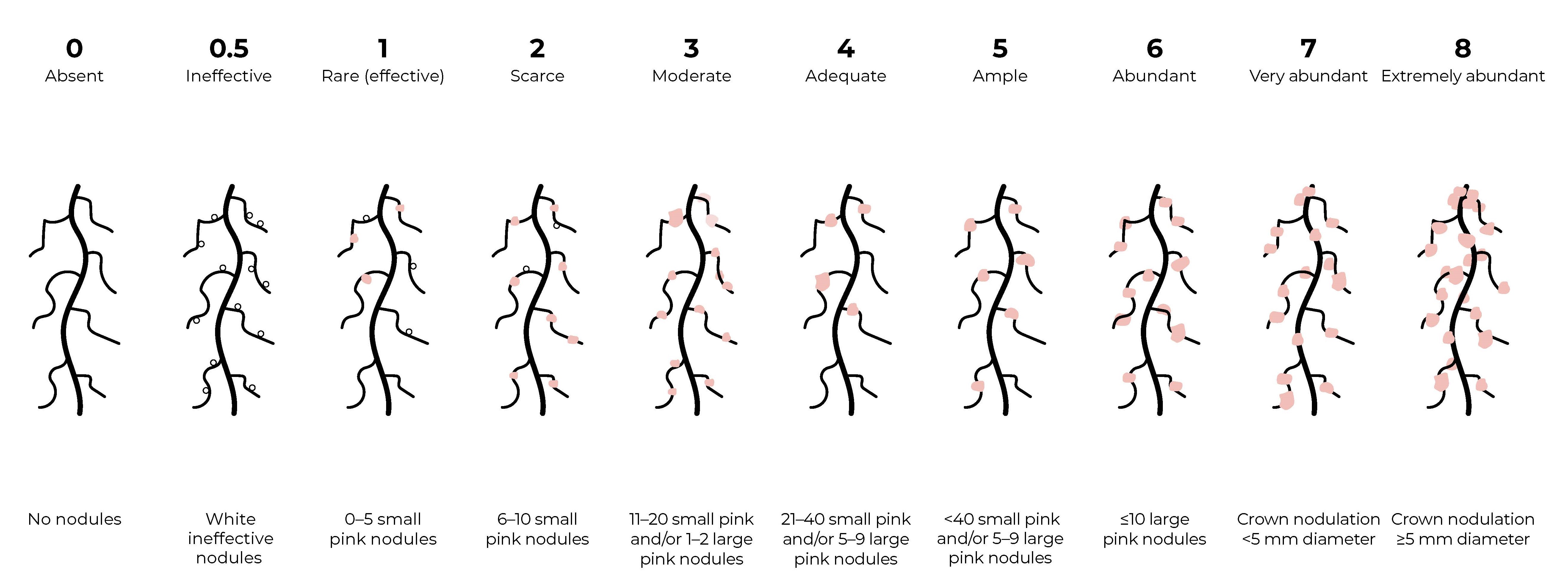
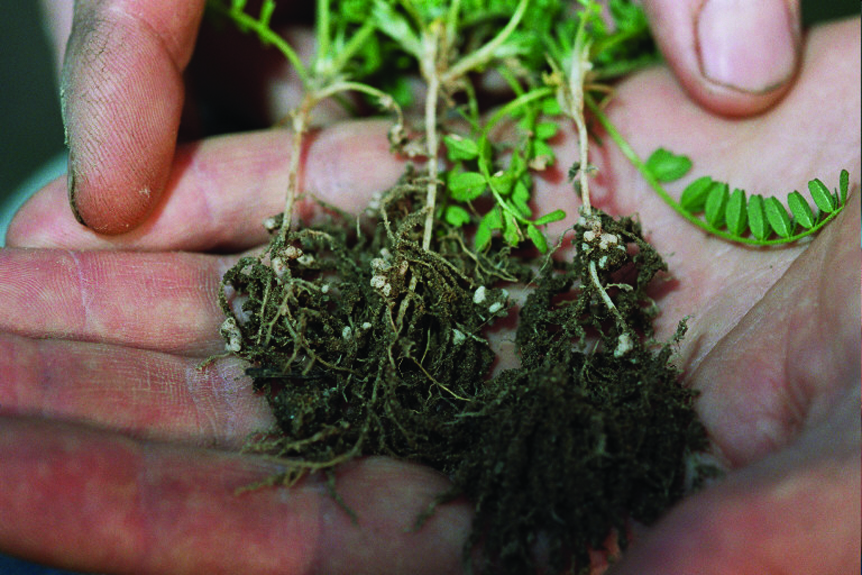
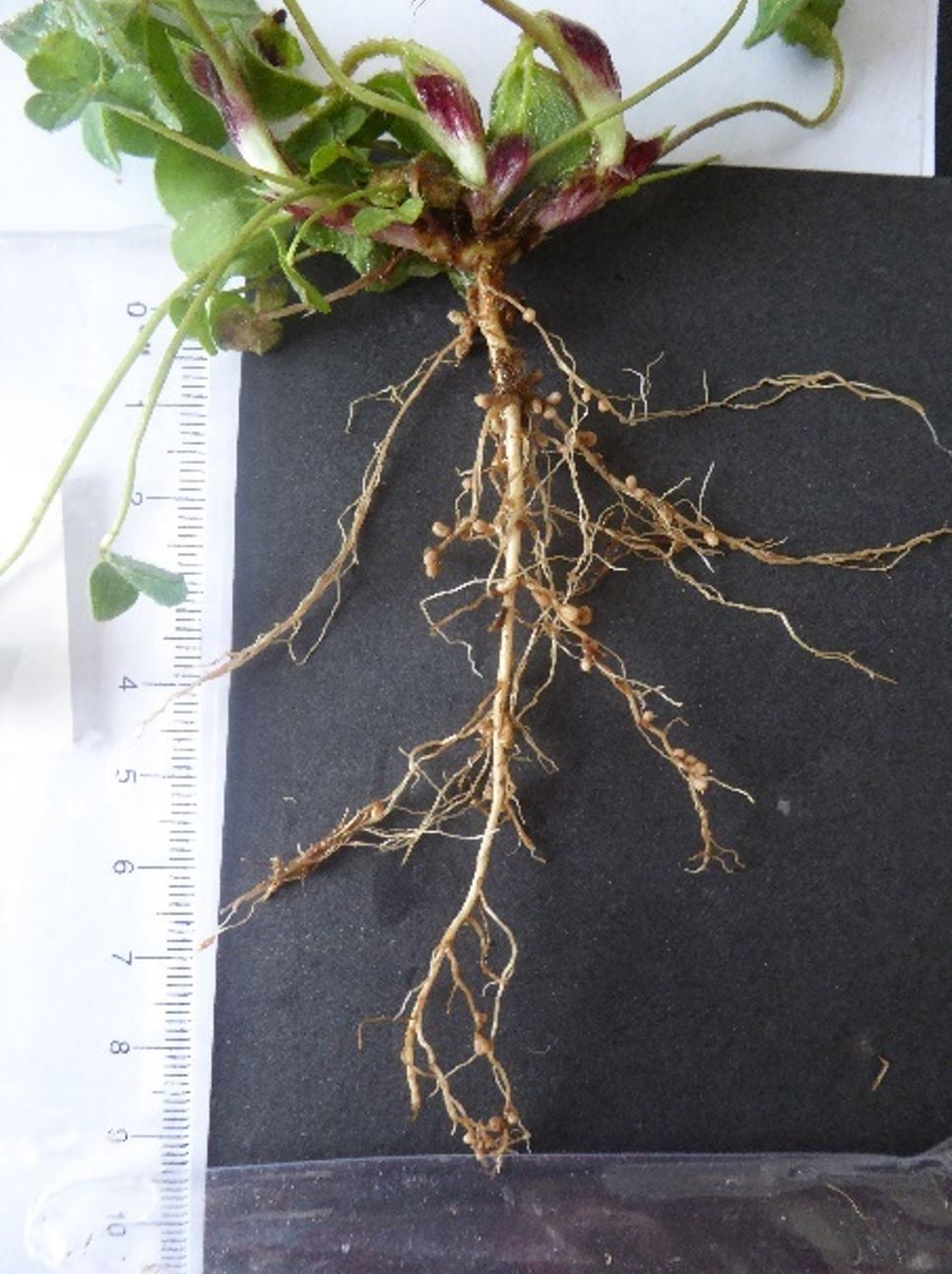
Protect the environment
Ensure the proposed nutrients do not adversely impact on the environment. Given the prevailing conditions in a paddock, e.g., proximity to drainage lines, amount of bare ground, etc., nutrients may be easily lost to erosion, run-off or leaching beyond the root zone.
The most common issues caused by poor or over-application of fertilisers are:
1. Groundwater pollution – nitrate leaching through the soil can present a serious health hazard and contributes to soil acidification. When high rates of nitrogen are used or where clover grass pastures fix substantial nitrogen, especially on sandy or permeable soils, inevitably some nitrate is leached and may enter groundwater if there is a water table. If this groundwater is used for domestic supplies, the leaching presents a serious health hazard. To reduce the risk of leaching, apply nitrogen fertiliser in small amounts frequently rather than all at once.
2. Eutrophication – the enrichment of water by the addition of nutrients. The extra nutrients encourage the growth of algal blooms, particularly in stagnant water. Blue–green algae may produce toxins poisonous to animals, including humans. For algae to grow, phosphorus must be present in the water above a certain level. Phosphorus may be introduced into waterways in run-off from pasture, forests and fertilised land, and in drainage from irrigated land and urban areas. These sources, representing most of the total run-off, normally contribute low concentrations of phosphorus and are referred to as diffuse or non-point sources. Point sources, such as sewage effluent and drainage from dairies and feedlots, contribute smaller flows but contain much higher concentrations of phosphorus. These are frequently found to be the sources for most of the phosphorus found in waterways. To reduce the risk of contributing to phosphorus run-off, don't top dress dams, streams or swampy areas, or bare ground, and avoid topdressing when heavy rain is expected. Maintain good groundcover around dams and streams.
-
- addition of nitrogen to the soil by fertiliser or fixation of atmospheric nitrogen, followed by loss of nitrate from the soil due to leaching or run-off.
- production of organic acids from decomposing organic matter.
- removal of alkaline products such as hay from the soil.
- Use the least acidifying fertiliser you can find (for example, use urea rather than ammonium sulphate).
- Incorporate stubbles into fallow to minimise net nitrification.
- Sow early to maximise the opportunity of the crop to recover soil nitrate.
- Use perennial, deep-rooted plants able to rapidly absorb mineralised nitrate at the start of the growing season and maintain low soil nitrate levels throughout the year.
- Use deep-rooted crops.
- Minimise water percolation below the root zone.
- Avoid excessive irrigation.
- Minimise removal of product from the soil. To prevent acidification, you need to apply 55–60 kg of lime for every tonne of lucerne or clover hay removed; 35 kg of lime per tonne of grass hay removed; 22 kg of lime per tonne of cereal hay removed; and 3 kg of lime per tonne of cereal grain removed.
- Minimise manure removal from pastures, preferably leaving manure where the animals graze.
- Feed hay on the paddocks where it is cut.
- Use cropping rotations to minimise excessive accumulations of soil organic matter under pasture.
4. Cadmium build-up – cadmium is present in tiny amounts (less than 0.5 mg/L) in the soil, and in larger amounts in rock phosphate. Plant uptake of cadmium is small, but when plants containing cadmium are grazed by livestock, the cadmium accumulates in offal and may reach very high concentrations. This is a severe problem on the sandy grazing soils of South Australia and Western Australia but is not a problem on soils with even a low clay content.
Use tool 7.4 to quickly assess any potential nutrient losses.
Economics of fertilising pastures
The economic benefit of correcting nutrient deficiencies was evaluated by more than 100 producers (in VIC, NSW, TAS and SA) who participated in the Grasslands Productivity Program (GPP) from 1993 to 1997 (table 7.1). Pasture types ranged from improved perennial to annual to native. The average return was $1.89 for every dollar spent on fertiliser and livestock. Although livestock gross margins and fertiliser prices have changed since then, the response to fertiliser and resulting ability to increase stocking rate from the program will still hold true. Gross margins from 2016 to 2020 averaging approximately $35/DSE for wool sheep (source: Victorian Farm Monitor Program) make investing in fertiliser attractive.
| Parameter | GPP (VIC, NSW, SA, TAS) | Victorian GPP sites | NSW GPP sites |
| Change in stocking rate | Data unavailable | +28% | +34% |
| Change in gross margin | +25% | +25% | +30% |
| $ Return per $ spent | $1.89 | $2.17 | $2.28 |
SIGNPOSTS
Read
Healthy, fertile soils drive pasture productivity and deliver environmental benefits through improved water and nutrient use with less risk of surface run-off, erosion and deep drainage.
Provides a list of soil and plant testing laboratories that are part of the ASPAC testing proficiency program.
A practical manual explaining the basics of soil-plant relationships and the principles of fertiliser use, looking at types of soil, how they are classified and the interaction of soil, water and nutrients. It also provides an insight into how plants utilise nutrients and the role individual nutrients play in the process of plant growth.
A practical guide to soil tests, what soil tests are, when they can be used reliably and consistently, and discusses what limits their application.
An easily accessible compilation of data summarising the range of nutrient concentration limits for crops, pastures, vegetables, fruit trees, vines, ornamentals and forest species.
Covers all aspects of sheep farming for meat and wool production throughout temperate Australia, and chapter 2 is titled ‘Pasture growth and management’
A wealth of information regarding pasture production from grazing land.
Information on molybdenum, boron, zinc, copper, cobalt and selenium requirements for pastures and animals.
Micronutrient deficiencies can result from removal of agricultural products over many years, changes in soil acidity, or large increases in plant biomass as a result of added nitrogen fertiliser. This page is specific to high rainfall (more than 600 mm average annual rainfall) pastures in the south-west of Western Australia.
A significant proportion of the Western Australian production zone includes soils that have physical or chemical limitations that require management to minimise their effect on plant growth and potential yield. To better understand the potential productivity of soil, it is important to examine key soil characteristics and indicators.
Research and development outcomes and management guides from NSW.
Technical information on soils, from properties to testing and common issues.
Information from Victoria on the strengths and weaknesses of different soils for agricultural production, soil monitoring and managing problem soils.
Land use and management, resource assessments and information on managing common soil complaints for Tasmania.
Use
Allows producers and advisors to understand the value of soil testing and how to use soil test information to plan fertiliser investments. The tool is intended to assist producers in determining suitable levels of P-fertilisation of temperate pastures grazed by sheep and beef cattle on acid soils in southern Australia.
ATTEND
A coaching and training package developed to help producers get the most bang for their fertiliser buck. Skills learnt include interpreting a soil test, calculating rate and fertiliser type, prioritisation of paddocks and return on investment using decision guides.
Skills to identify possible soil constraints within southern Australian pasture systems.
Tips and tricks to utilise soil testing as a management tool that gives a measure of soil fertility and conditions.
Provides producers with a relatively quick and simple process to identify the nodulation status of their pasture legumes.





